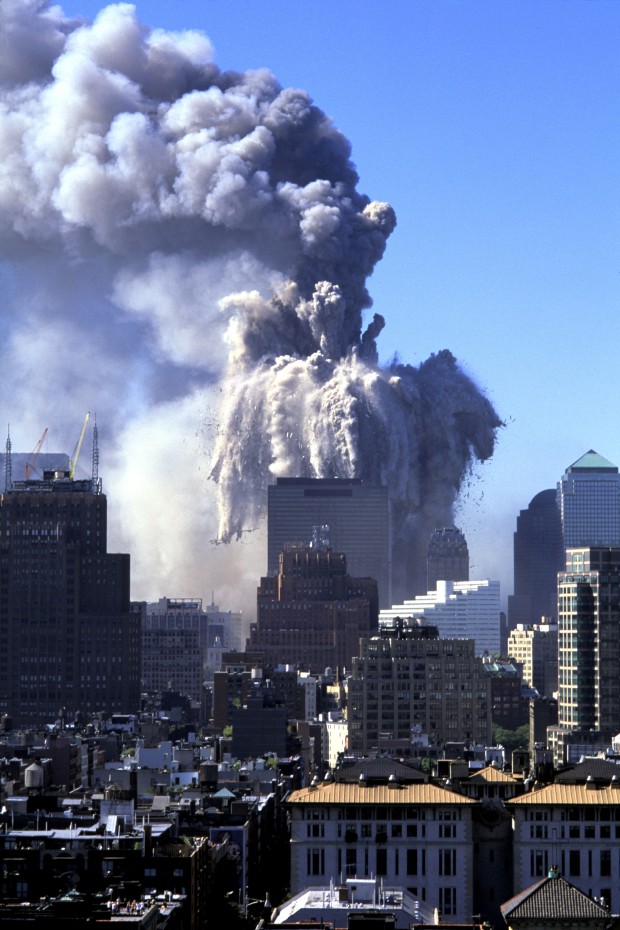June 18, 2008
(Updated 8/29/23)
Not So Deep Impact

[Notice: 1 WTC (North Tower) isn't collapsing in on itself, the structure has turned to particles, where the steel from the tower's skeleton structure is being blown outwards, while massive explosions erupt upwards then overreach the tower's footprint.
It should also be pointed out that the areas above both towers' impact zones must be in-tact in order to implode each tower, their in-tact structures resting atop the otherwise imploded rubble.]

"The buildings have been investigated and found to be safe in an assumed collision with a large jet airliner (Boeing 707 - DC 8) traveling at 600 miles per hour. Analysis indicates that such collision would result only in local damage which would not cause collapse or substantial damage to the building and would not endanger the lives and safety of occupants not in the immediate area of impact." Appendix A, NIST NCSTAR 1-2, December 1, 2005.
"Our analysis indicated the biggest problem would be the fact that all the fuel (from the airplane) would dump into the building. There would be a horrendous fire. A lot of people would be killed," he said. "The building structure would still be there." John Skilling, Lead Structural Engineer for the WTC, The Seattle Times, February 27, 1993.
Kinetic Energy Calculations of Flight 11 and Flight 175 Impacts
------------------------------------------------------------------
Formula for Kinetic Energy (KE)
KE = 0.5 · M · V2
-------------------------------------------------------
Takeoff Weights for Boeing 767 –200ER and Boeing 707 –320B
The Maximum Takeoff Weight for a Boeing 767 -200ER is 179,170 kg
(Boeing 767)
The Maximum Takeoff Weight for a Boeing 707-320B is 152,400 kg
(Boeing 707-320B)
---------------------------------------------------------
Aircraft Type, Speed and Kinetic Energy Impact Calculation the WTC Towers Were Designed to Withstand and Survive
KE of Boeing 707 at 270 m/s*
(0.5) · (152,400 kg) · (270)2
= 76,200 kg · 72,900
= 5,554,980,000 Joules
--------------------------------------------------------
Actual Aircraft Types, Impact Speeds of Flights 11 and 175 and Kinetic Energy Impact Calculations
Flight 11 Impact Speed into North Tower at 08:46:
KE of Boeing 767 at 198 m/s**
(0.5) · (179,170 kg) · (198)2
= 89,585 · 39,204
= 3,512,090,340 Joules
Flight 175 Impact Speed into South Tower at 09:03:
KE of Boeing 767 at 243 m/s**
(0.5) · (179,170 kg) · (243)2
= 89,585 · 59,049
= 5,289,904,665 Joules
---------------------------------------------------------
*270 m/s = 600 mph.
**NIST reports the impact speed of Flight 11 at 440 mph (198 m/s) and the impact speed of Flight 175 at 540 mph (243 m/s).
---------------------------------------------------------
As is readily observed in the above calculations, the kinetic energy unleashed upon the towers by the impacts of Flights 11 and 175 fell well within the capabilities of the towers to withstand such trauma. The towers were built to survive the impact of a Boeing 707 traveling at 600 miles per hour (965.6 km/h). The kinetic energy of such a strike would unleash 5,554,980,000 Joules. Although the Boeing 767s that struck the towers on September 11, 2001 were each approximately 59,000 lbs. (26,770 kg) heavier than the Boeing 707s the designers of the towers had based their calculations on, the reduced airspeeds of the impact aircrafts over-compensated for this greater weight, resulting in less kinetic energy expended.
The kinetic energy expended in the first strike on the North Tower by Flight 11 is calculated at a shockingly low 3,512,090,340 Joules, far below the 5,554,980,000 Joules the towers were designed to withstand and survive. The greater velocity of Flight 175 (540 mph or 874.8 km/h vs. 440 mph or 712.8 km/h for Flight 11), resulting in a kinetic energy calculation of 5,289,904,665 Joules, is still below the designers’ allowance of 5,554,980,000 Joules for the towers. These calculations prove that the towers should have survived the structural damage inflicted on them by the impact of Flights 11 and 175.
In regards to the fires in both towers, their severity and run-time were inconsequential. The National Institute of Standards and Technology (NIST) admits as much in its failure to analyze the massive heat sink properties of the towers.1 This inexplicable failure on the part of NIST is de facto recognition that fire was not the cause of the towers’ collapse. Not helping NIST on this matter is the agency’s continued stonewalling of calls from the engineering community to release the computer simulation models used to determine the fire damage to the towers’ steel.2 Is it any wonder then that the former chief of NIST’s Fire Science Division, James Quintieri, has called for an independent review into the NIST investigation.3
It should also be noted that the maximum jet fuel capacity for a Boeing 707-320B is 23,000 gallons,4 while the maximum jet fuel capacity for a Boeing 767-200 is 23,980 gallons.5 The actual amount of jet fuel that spilled into each tower was approximately 10,000 gallons,6 13,000 gallons less than the designers of the towers had allowed for to spill into the buildings.
----------------------------------------------------------------------------------------
1. The NIST Report on the World Trade Center Collapse one year later: Still Dead On Arrival, Mark H. Gaffney
2. Parker, Dave. "WTC investigators resist call for collapse visualisation." New Civil Engineer, November 1, 2005.
3. HEARING BEFORE THE COMMITTEE ON SCIENCE, HOUSE OF REPRESENTATIVES (OCTOBER 26, 2005)
4. Boeing 707-320B
5. Boeing 767
6. FEMA403 -- Chapter 2 - Federal Emergency Management Agency


Comments
Post a Comment